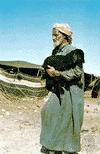- Bedouin
-
—Bedouinism, n.n.1. an Arab of the desert, in Asia or Africa; nomadic Arab.2. a nomad; wanderer.adj.3. of, pertaining to, or characteristic of the Bedouin.Also, Beduin.[1350-1400; ME Bedoyn < MF beduyn < Ar badawi desert-dweller (badw desert + -i suffix of appurtenance)]
* * *
Any member of a community of Arabic-speaking desert nomads of the Middle East.Ethnically, the Bedouin are identical to other Arabs. Bedouin traditionally have made their living by animal husbandry, and social rank among them is determined by the animals that they herd: camel nomads enjoy the greatest status, followed by sheep and goat herders and, finally, cattle nomads. Traditionally, Bedouin would migrate into the desert during the rainy season and return to cultivated areas during the dry season, but since World War II (1939–45) the governments of many countries have nationalized their range lands, and conflicts over land use have arisen. Many Bedouin have since adopted sedentary ways of life; most, however, retain pride in their nomadic heritage. Bedouin with a young goat in central QatarM. Ericson/Ostman Agency
Bedouin with a young goat in central QatarM. Ericson/Ostman Agency* * *
▪ peopleArabic-speaking nomadic peoples of the Middle Eastern deserts, especially of Arabia, Iraq, Syria, and Jordan.The Bedouin constitute only a small part of the total population of the Middle East but inhabit or utilize a large part of the land area. Most of them are animal herders who migrate into the desert during the rainy winter season and move back toward the cultivated land in the dry summer months. Although the Bedouin, as a matter of caste, traditionally despise agricultural work and other manual labour, many of them have become sedentary as a result of political and economic developments, especially since World War II. In the 1950s, Saudi Arabia and Syria nationalized Bedouin range lands, and Jordan severely limited goat grazing. Conflicts over land use between Bedouin herders on the one hand and settled agriculturists on the other have increased since then.The traditional Bedouin can be classified according to the animal species that are the basis of their livelihood. First in prestige are the camel nomads, who occupy huge territories and are organized into large tribes in the Sahara, Syrian, and Arabian deserts. Beneath them in rank are the sheep and goat nomads, who stay mainly near the cultivated regions of Jordan, Syria, and Iraq. Cattle nomads are found chiefly in South Arabia and in The Sudan, where they are called Baqqārah (Baggara).Following World War I the Bedouin tribes had to submit to the control of the governments of the countries in which their wandering areas lay. This also meant that the Bedouins' internal feuding and the raiding of outlying villages had to be given up, to be replaced by more peaceful commercial relations. Service in armed forces and even labour in construction became more common, especially after World War II. The tribal character of Bedouin society continued, however, as did the patriarchal order in their extended, patrilineal, endogamous and polygynous families. Among the Arabic-speaking tribes, the head of the family, as well as of each successively larger social unit making up the tribal structure, is called sheikh; (sheikh) the sheikh is assisted by an informal tribal council of male elders.In addition to the “noble” tribes who trace their ancestry to either Qaysi (northern Arabian) or Yamani (southern Arabian) origin, traditional Bedouin society comprises scattered, “ancestorless,” vassal tribal splinter groups who shelter under the protection of the large noble tribes and make a living by serving them as blacksmiths, tinkers, artisans, entertainers, and other workers.* * *
Universalium. 2010.
